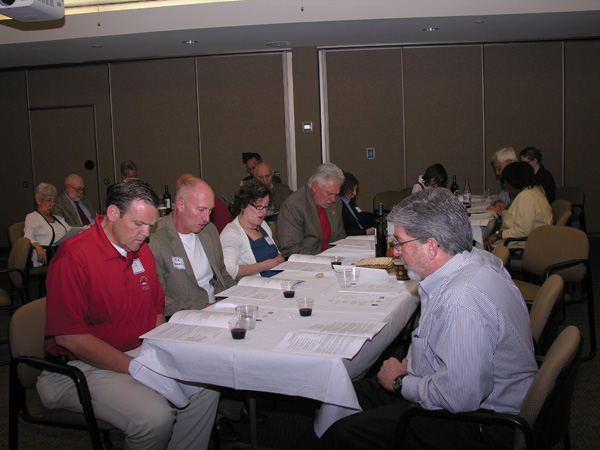JCRC welcomes labor leaders for seder
Published May 14, 2010
The right of workers to organize, reducing poverty in the Jewish community, early childhood education and concerns about nuclear weapons in Iran were among the many topics discussed at a “Labor Seder” last week, hosted by the Jewish Community Relations Council, the Jewish Labor Committee and supported by the Greater St. Louis Labor Council.
About 50 Jewish community leaders, labor union leaders and members and friends of the sponsoring groups attended the seder at the Jewish Federation Kopolow Building. The event typically takes place at least every two years.
Jewish involvement in the American organized labor movement has existed for more than a century. When large numbers of immigrant Jews came to America in the 1880s through the 1920s, many were forced to take work in horrific “sweat shops,” the most notorious of which was at the Triangle Shirtwaist Factory. A tragic fire claimed the lives of scores of young women who had to jump to their deaths to escape from the flames. That tragedy, along with deplorable hours, wages and working conditions gave impetus to the rise of such unions as the International Ladies Garment Workers Union, of which David Dubinsky was the founding and longtime president. Dubinsky was also the founding treasurer of the Jewish Labor Committee, an organization dedicated to fostering and maintaining close ties between the Jewish and organized labor communities.
Gerry Greiman, president of the JCRC welcomed the guests, who took a tour of the St. Louis Holocaust Museum and Learning Center just before gathering for the forum and “Labor Seder,” a special version of the Passover seder compiled by the Jewish Labor Committee.
The forum and seder offered “a unique opportunity for us to exchange views and ideas on meaningful issues facing both the American Jewish community as well as American organized labor,” said Greiman.
Labor legislative priorities
Bob Soutier, president of the Greater St. Louis Labor Committee, discussed the importance of the Employee Free Choice Act, EFCA, a bill sponsored by the AFL-CIO to give worker protection under the National Labor Relations Act, the major labor rights bill passed 70 years ago. “We hope to convince our Congressional delegation to understand our right to organize,” he said. “That’s the only purpose we have, to protect the rights of workers and to assure safe working conditions, and fair hours and wages. We cannot be fully effective under the present system in which the employers control the process by which votes by workers are conducted as to whether to organize. We want EFCA to pass to keep the rights of workers to organize and not to be intimidated in that process.”
Soutier said that the present system allows employers to thwart efforts by workers to affiliate with unions by controlling when and where the voting takes place and by removing the protection of a secret ballot. “Organized labor is responsible for bringing to American workers health care, days off, passing child labor laws and establishing pensions. To do these things, we need to be able to organize and remain strong.,” he said.
Ed Finkelstein, publisher of the St. Louis/Southern Illinois Labor Tribune, spoke against the so-called “Right to Work” laws, which have been passed in several states. He said they are “the most misnamed legislative idea in history.” He pointed out that a Right to Work initiative was defeated in 1978, but has been put forward again by opponents of organized labor.
“The so-called ‘Right to Work’ law is really a ‘right to work less,'” Finkelstein said. He cited an AFL-CIO poll indicating that as many as 80 percent of American workers would join unions if they were not intimidated from doing so. Right after World War II between 30 and 50 percent of workers were in unions; now that has dropped to about 11 percent, he said.
“We have to remember that organized labor created the middle class in America,” he said. “When unions were strong, the middle class was stronger. Now the middle class is shrinking and dying while the top 1 percent of the population has an increasing share of national income. Senate Bill 888 must be defeated in order to protect that right.”
JCRC perspectives
Phyllis Markus, JCRC vice president and chair of its Bohm Family Social Justice Initative, spoke about its “ambitious” goal, “to reduce poverty in our community in half in 10 years.”
“As you know, our challenges have escalated.,” she said. “The downturn in the economy has affected all of us, and many of those who felt secure in their lifestyle are now facing challenges of their own. So, in fact, our work and our goals have broadened.”
Markus said that a more recent focus of the social justice initiative is to work with children. “We have learned that there is a direct correlation between adequate early education and later success in life. And we have learned that economically it is by far the best investment of our time and money in our community,” she said.
Brad Kafka, a JCRC vice president and chair of its Iran Outreach Committee, addressed the attendees on “The Danger of a Nuclear Iran.”
Kafka expressed concern that if Iran got nuclear weapons, “then Egypt and Saudi Arabia would want them, which would set off a nuclear arms race in the Middle East. If sanctions and other actions by the international community won’t work to stop Iran from developing these weapons, it may come down to a stark choice between accepting a nuclear Iran, or military action to stop it. We hope it will not come down to this choice.”
Following the forum, Rabbi Brigitte Rosenberg conducted the “Labor Seder” from the special Hagaddah prepared by the Jewish Labor Committee. Her daughter, Zoe Rosenberg, asked the four questions.















